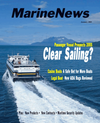
Page 28: of Marine News Magazine (January 2005)
Read this page in Pdf, Flash or Html5 edition of January 2005 Marine News Magazine
By Don Sutherland
There have been plenty of books pub- lished on the subject of tugboats in the past few years, sharing a cookie-cutter similarity - they're large, handsome, col- orful, well-produced coffee-table vol- umes, which pretty much cover the same introductory material in the same glancing way. In all those regards and quite a few more, Virginia Thorndike's On Tugboats is a different sort of book. For starters, it's not large nor particularly handsome, and not all that well-produced - a standard paperback printed in black-and-white on paper that will probably not last for cen- turies. But then, it is a book crying out to be read, where coffee-table books ask merely to be seen.
On Tugboats certainly should be read, for the reason expressed in its subtitle: "Stories of Work and Life Aboard." That's a type of work and a style of life without many parallels in other lines of business, which seldom has been examined. The other, more glamorous volumes may introduce the mate and state what time he gets up in the morning, his routine duties and what he eats for supper. Such matters are more in the background in On Tug- boats, which goes on to portray what the mate - and the skipper, the engineer, the deckhand, the tankerman, and those they have known - feel and think.
For these reasons alone, this book is bound to be read by many who work in this business. The sheer narcissism would be embellished by heartfelt chuckles, as the mariner recognizes familiar situations or, at least, situations that could have been familiar. As well, there's a certain amount of in-talk and gossipy stuff unlike that found on the "lifestyle" page of your hometown newspaper.
Does everyone know everything, for example, that links the tugs Fournier Girls and Mary L. McAllister? Everything?
Well, even this book may contain less than everything, but perhaps more than you knew before. It doesn't appear in any single place, though, under a subhead, "Links between the Girls and the Mary
L." The info comes out in dribs and drabs.
Like genuine gossip, it arises from sever- al conversations, and it's left to the reader to spot and correlate the connections.
Speaking as an Insider
Some of this same clannishness could pose a problem for the book, however, to whatever extent it aims to appeal to the lay public. They might be drawn to the pretty pictures of the coffee-table vol- umes. But On Tugboats, meant to be read, may put the newcomer at a bit of a disad- vantage with its technical jargon and nomenclature, which is dispensed as almost the King's English. The fact is that work and life aboard tugboats is suffused with specialized equipment, unique requirements, techniques and skills which are frequently unknown even to other mariners. A lot of this jargon may seem dense, particularly in the opening chapter, and although there's a glossary in the back, it may yet be challenging to the lay reader. "The eight-strand blend braid is more resistant to abrasion than the same blend in laid line," the text reports early-on, "because it spreads the pressure over a wider surface and offers fewer proud edges." This might not be Greek to a tug- boater, but it could elicit some head- scratching for, say, the wives or kids of the tugboater. They may take-up the book, the better to understand what their significant other actually does during those weeks away from home. Such readers should be consoled and counseled - hold-on, mateys, there's smoother sailing ahead, as the lingo lightens up.
The opening chapter is jargon-laden because it defines the tugboat, its princi- ples of design, its purpose, construction, and operation. It's required reading, to set the stage for the neophyte reader.
Explanatory footnotes would help, but would slow the narrative down and make the book like what it is not, a textbook.
Once the yarns get underway, the book adopts a unique pose, in a white-knuckle sort of way. Just a few pages past the fore- going quote, for example, the relevance of a towing line to things besides towing comes at the reader with a visceral impact. "Nylon lines store up tremendous energy when they stretch, which makes them potentially lethal when they part. 'I remember one report from over thirty years ago,'" a captain is quoted, "'where a crew on a ship was attempting to move a spare anchor using a nylon line. The line snapped, and amongst the dozen or so injured and killed, several were cut com- pletely in half.'"
Like it is
The tales are told in their tellers' voices - we gather the author used a recorder - in their own distinct lingoes, with a vocabu- lary more profane than sacred, accents and dialects intact. The author's tone, meanwhile, is the same as in her previous (and more genteel) works like "Windjam- mer Watching on the Coast of Maine," her characteristic style as raconteur being level and restrained, sort of a plain-vanil- la against the Cajun spice (or, if you pre- 28 • MarineNews • January, 2005
On The Bookshelf
On Tugboats
A year after 9/11 and the remarkable rally by New York's mariners, several of the participating tugboats commorated the anniversary with a parade past the former site of the twin towers. Many tales of the Evacuation of Lower Manhattan remain to be told. (Photo: Don Sutherland)
MN JAN05 3 (25-40).qxd 1/4/2005 3:31 PM Page 28

 27
27

 29
29
